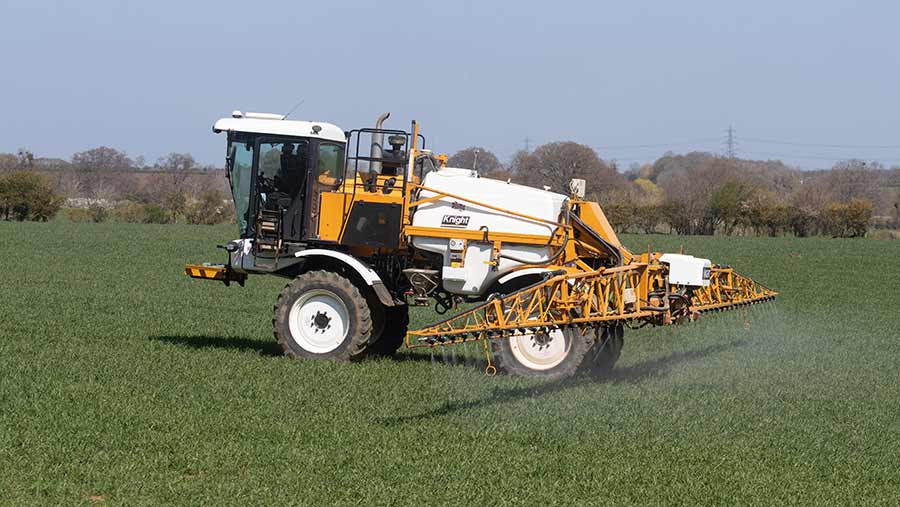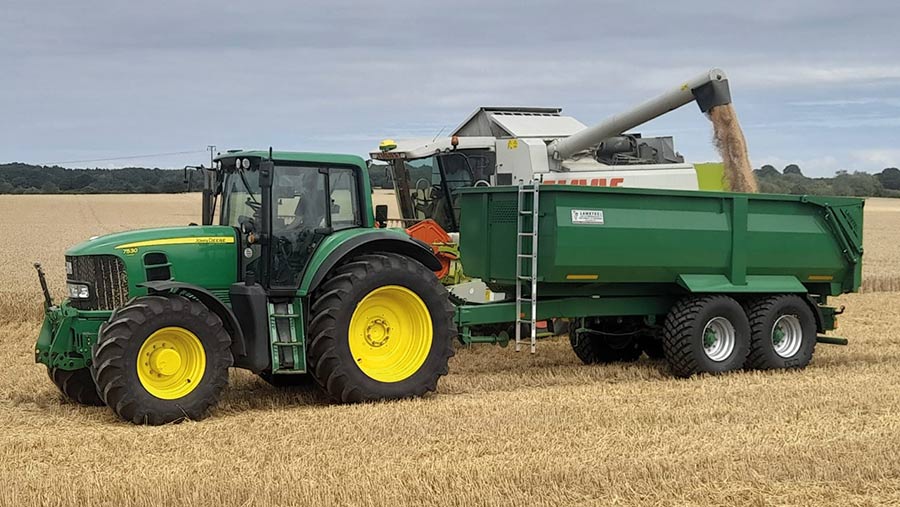Growers cut nitrogen and maintain yields using biostimulant
 © Tim Scrivener
© Tim Scrivener Two growers in Lincolnshire and Germany are using a biostimulant, which combines stabilised nitrogen with micronutrients, to allow them to cut back on expensive bagged fertiliser, while still maintaining yields.
Colin Chappell in north Lincolnshire and Thorben Wiese in continental Europe are both using the product AminoA BLAAZT, which can be mixed with most agrochemicals, to reduce costly nitrogen fertiliser usage.
See also: New wheat fungicide anticipated in disease resistance battle
Mr Chappell is using the biostimulant to cut nitrogen rate by 40kg/ha across his feed winter wheats, spring barley and oilseed rape, without any yield penalties, as part of a wider aim to cut nitrogen use on his Gander Farm, near Brigg.
“We are keen to try anything that can help us reduce reliance on nitrogen fertiliser and consequently our carbon footprint. This is why we are trying products such as this to help us achieve this goal,” he says.
Trimming nitrogen
On winter wheat, he applies two 10 litre/ha sprays of the biostimulant at the T0 and T1 timings.
The crop only received 180kg/ha of nitrogen and still shows yields of 10.5t/ha plus, with some as high as over 12t/ha, and he now plans to cut nitrogen rates by 10-15% each year.
“It’s important to build the sprays early on in a programme as part of a managed approach – the earlier, the better. Waiting until the T2 timing can be too late.
“What’s more, if crops become stressed in a dry spring, it’s no good trying to firefight the issue when it’s too late,” he says.
For spring barley, the biostimulant is applied at the 3-4 leaf stage, together with foliar manganese. This can save 40kg/ha of nitrogen and still gives yields of over 8t/ha.
While for oilseed rape, applications at the pod set stage can be mixed with a sclerotinia spray.
Although the product can be applied in a variety of tank mixes, it is not recommended to be added to acetolactate synthase (ALS) inhibiting herbicides.
However, applications of these can be made seven days after the biostimulant is applied.
German pressures

© Thorben Wiese
Over in Germany, Mr Wiese is seeing political and environmental pressure to cut back on chemical inputs, although he says reducing his carbon footprint is not currently being rewarded financially.
“However, as a farmer I have a responsibility to the next generation. It is a balance, as I need big crops, but I want them produced in a sustainable way,” he says.
Therefore, he is using the biostimulant across his first and second winter wheats, spring wheats and oilseed rape.
He is seeing yields of up to 11t/ha from first wheat with 170kg/ha of nitrogen and 9-9.5t/ha from second wheats with 185kg/ha, resulting in a 20-25% saving of nitrogen.
Spring wheats are yielding 7.8t/ha with 150kg/ha of nitrogen, representing a 10% cut from that used previously.
“The OSR stood on a block with a history of clubroot, so I did not have high expectations. However, it yielded 3.6t/ha from 140kg/ha of nitrogen – the same yield as neighbouring farms, with 20% less nitrogen,” he says.
The biostimulant
The biostimulant spray AminoA BLAAZT contains protected amine nitrogen, complexed calcium and boron, phosphate and potash, fulvic and humic acid, and a broad spectrum of L-isomer amino-acids.
The product aims to improve yield and quality in crops and cut fertiliser use, by harnessing amine nitrogen, which is normally only produced in the plant itself, explains Richard Phillips, managing director at AminoA.
In addition, it improves root development and reduces the risk of run-off of easily leached chemical fertilisers, allowing for efficient application in nitrate vulnerable zones, he adds.
Trial data
Higher winter wheat yields were seen when two sprays of the biostimulant were used, and bagged nitrogen rates cut by 25%, in trials conducted by Barworth Research.
Three treatments were used on the wheat variety Graham, grown on a loamy sandy soil in Lincolnshire, at a seed rate of 200kg/ha, using ammonium nitrate nitrogen.
The treatments were as follows:
- Standard 100% nitrogen rate (210kg/ha nitrogen with 10kg/ha of nitrogen soil reserve)
- 75% nitrogen rate
- 75% nitrogen rate with two 10 litre/ha applications of the biostimulant at T1 and T2 timings
The biostimulant-treated plot returned the highest yield of 11.65 t/ha.
This was above the 10.92t/ha of the untreated 100% nitrogen sample, and 10.54t/ha yield of the untreated 75% nitrogen plot.
With the reduced nitrogen used in the biostimulant plot, this represents a margin over fertiliser cost for the treated plot of £2,746.60/ha, which was £274.90 more than the 100% nitrogen untreated plot.
“The hybrid biostimulant product is not only maintaining, but in fact improving, yield and quality, while addressing environmental concerns by reducing the total nitrogen application needed on crops,” says Mr Phillips.
Cost comparison of biostimulant use in Lincolnshire trial |
|||
|
Treatment |
Standard 100% N rate |
75% N rate |
75% N rate + two applications of biostimulant (10 litres/ha) |
|
Yield (t/ha) |
10.92 |
10.54 |
11.65 |
|
Output (£/ha) |
3,035.76 |
2,930.12 |
3,238.7 |
|
N applied (kg/ha) |
210 |
157.5 |
157.5 + 3.2 |
|
N cost (£) |
564.06 |
422.1 |
422.1 + 70 |

